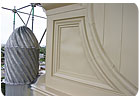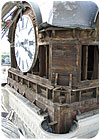Duplicating and Preserving History
The clock tower that adorned the county courthouse in Franklin County, Iowa, has long been a source of pride for county residents. But its external elegance belied the damage done by inferior work done by the original contractor - a contractor who was going bankrupt as the project was nearing completion in 1890. He ultimately finished the job, but he cut corners to save money.

 The clock tower that adorned the county courthouse in Franklin County, Iowa, has long been a source of pride for county residents. But its external elegance belied the damage done by inferior work done by the original contractor - a contractor who was going bankrupt as the project was nearing completion in 1890. He ultimately finished the job, but he cut corners to save money.
The clock tower that adorned the county courthouse in Franklin County, Iowa, has long been a source of pride for county residents. But its external elegance belied the damage done by inferior work done by the original contractor - a contractor who was going bankrupt as the project was nearing completion in 1890. He ultimately finished the job, but he cut corners to save money.
One hundred years later, Franklin County paid for the contractor’s cost-cutting, as chunks of the tower began raining down upon its citizens. After encircling the top of the building with chicken wire, county officials began the bid process for rebuilding and restoring this historic gem. The problem was finding a company capable of restoring the courthouse so that it retained its historic value and appearance - and so that it remained on the National Registry of Historic Places, a distinction it had held since 1976.
Enter Renaissance Roofing, a specialty roofing company headquartered just outside of Chicago in Belvidere, Ill. The company was founded 15 years ago and completes residential and commercial roofing projects across the country. One of three companies to submit a bid for the Franklin County Courthouse project, Renaissance ultimately won the project based on its national reputation for its slate and tile roofing projects. “Our experience with highly technical and specialty roofing laid the groundwork for the courthouse job,” said Robert W. Raleigh III, Renaissance Roofing’s General Manager and son of the company’s founder. “Once we arrived on site in Iowa, it was clear we had our work cut out for us.”
Originally, the tower was constructed with a post-and-beam skeleton wrapped in terne metal. The metal overlay was attached to the wooden substructure using steel nails, which cut costs for the cash-strapped original contractor, but led to significant weather-related damage over the years. “Because the metal wasn’t water-tight, it caused extensive damage to the framing underneath, which all needed to be replaced,” explained Raleigh. Renaissance contracted with a carpentry firm that eventually replaced 400 linear feet of timber framing - a job that took six months and 6,000 man-hours in structural and finish carpentry work.
 Scaffolding was erected around the entire tower in July 2005. “Then we went up and documented the entire exterior in photos,” said Raleigh. Since Renaissance workers had no historical drawings or sketches from which to craft the new metal overlay, the photos were a critical first step in ensuring a historically accurate final product. “We took a photo of every part,” Raleigh continued. “And there were more than 1,700 individually stamped sheet metal ornaments.”
Scaffolding was erected around the entire tower in July 2005. “Then we went up and documented the entire exterior in photos,” said Raleigh. Since Renaissance workers had no historical drawings or sketches from which to craft the new metal overlay, the photos were a critical first step in ensuring a historically accurate final product. “We took a photo of every part,” Raleigh continued. “And there were more than 1,700 individually stamped sheet metal ornaments.”
Dismantling and salvage alone took four weeks to complete. Aside from the photography, labeling and cataloging, Renaissance also had to contend with 100 years’ worth of Mother Nature. “The pigeons were pretty upset because they had lived in the tower for generations,” Raleigh recalled. “There were literally hundreds of pounds of bird excrement up there.”
Once dismantled, the crew hauled the salvaged metal back to Renaissance’s Belvidere headquarters, where they painstakingly laid out every piece, replicating the project on their shop floor. “Then the real work began,” said Raleigh. “We replaced 100 percent of the original sheet metal, turning out 10,000 square feet of Follansbee Steel’s Terne Coated Stainless Steel Two (TCSII), which was the material the project’s architects specified.” Workers used brake forming, metal stamping and pressing, and metal formed on planishing hammers and an English Wheel to manufacture the new pieces. The team also put in hundreds of hours of hand-hammering parts on a lead shot bag.
 Adding to the challenge of the project were two factors: One, Renaissance Roofing, long known for its tile and slate roof expertise, had never worked in stamped metal and two, there are not as many experienced sheet metal workers as when the courthouse was constructed.
Adding to the challenge of the project were two factors: One, Renaissance Roofing, long known for its tile and slate roof expertise, had never worked in stamped metal and two, there are not as many experienced sheet metal workers as when the courthouse was constructed.
“There simply aren’t as many sheet metal craftsmen now as there were in 1890, and their craftsmanship and ingenuity was simply impeccable,” said Raleigh. “My staff learned a lot through this project; we simply don’t have the same type of skills as they did 100 years ago.”
With in-shop fabrication complete, the Renaissance crew returned to Franklin County in November 2005 for on-site installation. Workers had to contend with the extremes of Midwestern weather throughout the installation process, which lasted 13 months, until December 2006. With the base of the tower reaching to 70 feet, and the top of the tower scaling to 125 feet, workers had to deal with sun, cold and wind constantly. “On a calm day, winds were blowing 20 to 30 miles per hour up there,” recalled Raleigh.
 Crews began by putting base metal on the substructure, but instead of using steel nails like the original contractor, Renaissance installed interlocking panels with a hidden cleat joint and hand-soldered the seams, creating a waterproof seal over the wood. Once the base metal was locked down, the crews added the ornamentation, repaired the copper statues, replaced the copper dome, and cleaned, repaired and reworked the clock’s face, hands, numbers and marks. In all they fully replaced all of the clock tower’s architectural sheet metal, nearly all of the timber framing and replaced five flat roof systems on the building.
Crews began by putting base metal on the substructure, but instead of using steel nails like the original contractor, Renaissance installed interlocking panels with a hidden cleat joint and hand-soldered the seams, creating a waterproof seal over the wood. Once the base metal was locked down, the crews added the ornamentation, repaired the copper statues, replaced the copper dome, and cleaned, repaired and reworked the clock’s face, hands, numbers and marks. In all they fully replaced all of the clock tower’s architectural sheet metal, nearly all of the timber framing and replaced five flat roof systems on the building.
In addition to the extremes of weather, crews measured progress on this job in inches per day, not feet. “This type of work requires a high level of patience,” said Raleigh. “It takes a special person to go out there day after day and work but see very little progress.”
On-site installation was completed in December 2006, and crews returned in March 2007 to put the finishing touches on the job, including painting the steel to match the courthouse and using a crane to place the statue that resides at the top of the tower. The results are impressive. “This project cost $1.5 million and took 21 months to complete, but it was worth it,” concluded Raleigh. “It looks great - and it truly now lives up to its designation on the National Register of Historic Places.”
For more information about Renaissance Roofing, call 800-699-5695 or visit www.claytileroof.com .
• 10,000 square feet of Follansbee Steel’s Terne Coated Stainless Steel (TSCII) used.
• 6,000 man-hours in structural and finish carpentry work.
• 1,700-plus individually stamped sheet metal ornaments.
• 400-plus linear feet of timber framing replaced.
• 125 feet of elevation to top of tower.
• 70 feet of elevation to base of tower.
• 100-plus pieces of hand-hammered curved parts installed.
• 100-plus pieces of metal custom-formed on an English Wheel.
• 20 different individual molds required for stamped sheet metal components.
• 5 historic copper statues repaired.

The clock tower that adorned the county courthouse in Franklin County, Iowa, was built in 1890. It was restored by Renaissance Roofing of Belvidere, Ill.

The restored courthouse tower retained its designation on the National Register of Historic Places.
One hundred years later, Franklin County paid for the contractor’s cost-cutting, as chunks of the tower began raining down upon its citizens. After encircling the top of the building with chicken wire, county officials began the bid process for rebuilding and restoring this historic gem. The problem was finding a company capable of restoring the courthouse so that it retained its historic value and appearance - and so that it remained on the National Registry of Historic Places, a distinction it had held since 1976.
Enter Renaissance Roofing, a specialty roofing company headquartered just outside of Chicago in Belvidere, Ill. The company was founded 15 years ago and completes residential and commercial roofing projects across the country. One of three companies to submit a bid for the Franklin County Courthouse project, Renaissance ultimately won the project based on its national reputation for its slate and tile roofing projects. “Our experience with highly technical and specialty roofing laid the groundwork for the courthouse job,” said Robert W. Raleigh III, Renaissance Roofing’s General Manager and son of the company’s founder. “Once we arrived on site in Iowa, it was clear we had our work cut out for us.”
Originally, the tower was constructed with a post-and-beam skeleton wrapped in terne metal. The metal overlay was attached to the wooden substructure using steel nails, which cut costs for the cash-strapped original contractor, but led to significant weather-related damage over the years. “Because the metal wasn’t water-tight, it caused extensive damage to the framing underneath, which all needed to be replaced,” explained Raleigh. Renaissance contracted with a carpentry firm that eventually replaced 400 linear feet of timber framing - a job that took six months and 6,000 man-hours in structural and finish carpentry work.

This detail shows a hand-hammered ornament on the left and the restored clock paneling to the right.
Dismantling and salvage alone took four weeks to complete. Aside from the photography, labeling and cataloging, Renaissance also had to contend with 100 years’ worth of Mother Nature. “The pigeons were pretty upset because they had lived in the tower for generations,” Raleigh recalled. “There were literally hundreds of pounds of bird excrement up there.”
Once dismantled, the crew hauled the salvaged metal back to Renaissance’s Belvidere headquarters, where they painstakingly laid out every piece, replicating the project on their shop floor. “Then the real work began,” said Raleigh. “We replaced 100 percent of the original sheet metal, turning out 10,000 square feet of Follansbee Steel’s Terne Coated Stainless Steel Two (TCSII), which was the material the project’s architects specified.” Workers used brake forming, metal stamping and pressing, and metal formed on planishing hammers and an English Wheel to manufacture the new pieces. The team also put in hundreds of hours of hand-hammering parts on a lead shot bag.

This photo shows the clock face during the removal of the damaged sections of the tower. The original metal wasn’t water-tight, and the framing below was damaged.
“There simply aren’t as many sheet metal craftsmen now as there were in 1890, and their craftsmanship and ingenuity was simply impeccable,” said Raleigh. “My staff learned a lot through this project; we simply don’t have the same type of skills as they did 100 years ago.”
With in-shop fabrication complete, the Renaissance crew returned to Franklin County in November 2005 for on-site installation. Workers had to contend with the extremes of Midwestern weather throughout the installation process, which lasted 13 months, until December 2006. With the base of the tower reaching to 70 feet, and the top of the tower scaling to 125 feet, workers had to deal with sun, cold and wind constantly. “On a calm day, winds were blowing 20 to 30 miles per hour up there,” recalled Raleigh.

When chunks of concrete began falling from the tower, it was encased in chicken wire while city officials sought a contractor to restore the historic structure.
In addition to the extremes of weather, crews measured progress on this job in inches per day, not feet. “This type of work requires a high level of patience,” said Raleigh. “It takes a special person to go out there day after day and work but see very little progress.”
On-site installation was completed in December 2006, and crews returned in March 2007 to put the finishing touches on the job, including painting the steel to match the courthouse and using a crane to place the statue that resides at the top of the tower. The results are impressive. “This project cost $1.5 million and took 21 months to complete, but it was worth it,” concluded Raleigh. “It looks great - and it truly now lives up to its designation on the National Register of Historic Places.”
For more information about Renaissance Roofing, call 800-699-5695 or visit www.claytileroof.com .
Sidebar: By the Numbers
• 12,500 man-hours in metal fabrication and installation by Renaissance Roofing.• 10,000 square feet of Follansbee Steel’s Terne Coated Stainless Steel (TSCII) used.
• 6,000 man-hours in structural and finish carpentry work.
• 1,700-plus individually stamped sheet metal ornaments.
• 400-plus linear feet of timber framing replaced.
• 125 feet of elevation to top of tower.
• 70 feet of elevation to base of tower.
• 100-plus pieces of hand-hammered curved parts installed.
• 100-plus pieces of metal custom-formed on an English Wheel.
• 20 different individual molds required for stamped sheet metal components.
• 5 historic copper statues repaired.
Looking for a reprint of this article?
From high-res PDFs to custom plaques, order your copy today!



